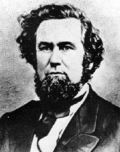Confederate election
| |||||||||||||||||||||
| |||||||||||||||||||||
 | |||||||||||||||||||||
| |||||||||||||||||||||
The 1863 Virginia Confederate gubernatorial election was held on May 28, 1863, to elect the Confederate governor of Virginia. At the time, the governorship of the state was disputed as a result of the American Civil War.
| Party | Candidate | Votes | % | |
|---|---|---|---|---|
| Democratic | William Smith | 28,613 | 47.77% | |
| Democratic | Thomas Flournoy | 23,453 | 39.16% | |
| Democratic | George Wythe Munford | 7,478 | 12.49% | |
| Write-ins | 353 | 0.59% | ||
| Total votes | 59,987 | 100.00% | ||
| Democratic hold | ||||




